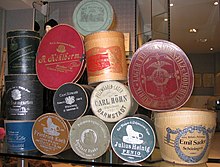

A hat box (also commonly hatbox and sometimes hat bucket, hat tin or bandbox) is a container for storing and transporting headgear, protecting it from damage and dust. A more generic term for a box used to carry garments, including headgear, is a bandbox. Typically, a hat box is deep and round in shape, although it may also be boxlike and used as an item of luggage for transporting a variety of hats. [1]
Contents
Hat boxes may be made of a range of materials, including cardboard, leather or metal. [2] They may include straps or a carrying handle for transportation. More luxurious models may be padded and lined in materials such as silk in order to protect the headgear. [3]
